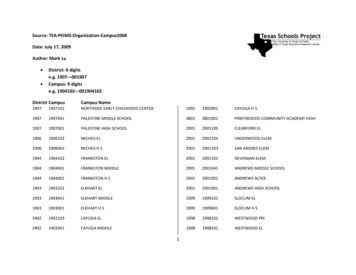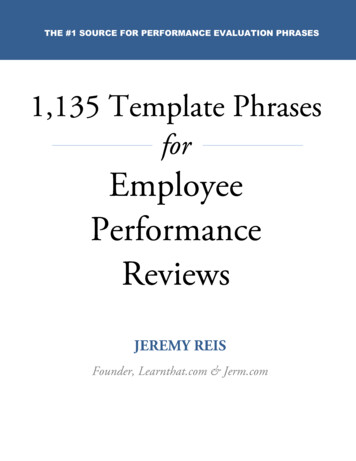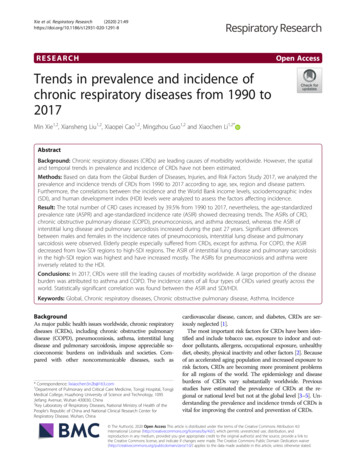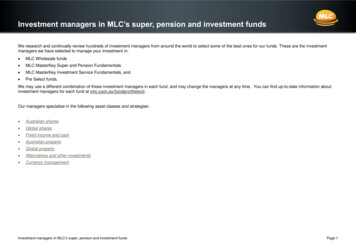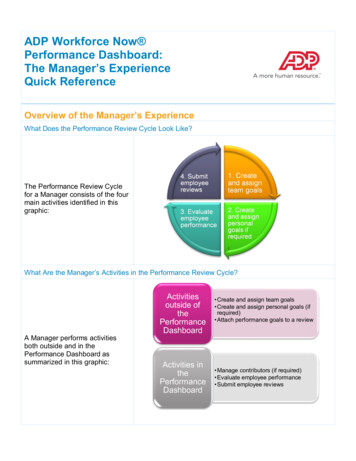
Transcription
3rd International Conference on Education, Management, Arts, Economics and Social Science (ICEMAESS 2015)Review on middle managers’ performance appraisalJunying Jia1, a, Jianxin Shi2, b1Department of Business Administration, Harbin Institute of Technology, Harbin, 150001, China2Department of Business Administration, Harbin Institute of Technology, Harbin, 150001, Chinaaemail: 625010589@qq.com, bemail: sjx@hit.edu.cnKeywords: Middle manager; Performance appraisal; Enterprise; Feedback; Goal settingAbstract. Literatures on middle managers’ performance appraisal are reviewed in this paper. Tosummarize methods and limitations on evaluating middle managers’ performance appraisal, aconceptual framework is developed. Based on the review, improvement of the methods for futureresearch and the scientific appraisal for achieving enterprise’s goals are discussed.IntroductionWith the development of society and global economy, the research of human resourcesmanagement is getting developed gradually.Human resource is a company’s most important and special resource. Hence, focusing on humanresource management is vital of importance. In particular, performance appraisal is a crucial part toachieve enterprise’s goals, which is one of core functions of human resource management [1].Performance appraisal can provide important information and reference to companies’ training,promotion, payment, rewards, punishment and so on [2].Middle managers are mediators and negotiators between organizations’ institutional andtechnical or operational levels and they play an important role in implementing organizationalpolicies and practices [3].Given their proximity to the operational level, middle managers are critical in enterprise’soperation. Within the context of human resource management (HRM), particular attention has beenpaid to evaluate middle managers’ performance. The aim of the current study is to summarize anddevelop this stream of research by reviewing middle managers’ performance appraisal.BackgroundPerformance appraisal is an evaluative process whereby managers rate and deliver feedbackregarding employees' performance.Some academicians believe that performance appraisal should be contacted with jobresponsibilities. Hence, it should based on work analysis and it should be carried out around thecharacteristics of the job [4].It’s noted that performance criterion should be based on work rather than workers. What’s more,middle managers and their superior should reach an agreement on the fairness of the criterion. It isvital of importance to encourage them and appraisal criterion is also the basis of appraisal.It was proposed the difference of task performance and contextual performance. After that theresearch of performance appraisal has made a new breakthrough. By using critical incident analysis,Borman and Brush came out 18 dimensions of managers’ performance in the process of the work oftask survey, interview and observation [5].Borman, Brush, Van. Scotter and Motowidlo (1996) did a comprehensive study on contextualperformance. They studied two dimensions of task performance, which include technologyadministrator task performance, leadership task performance. And they also studied two dimensionsof contextual performance, which include job dedication and interpersonal facilitation.Many studies explored the performance structural problems. One of the most basic theoreticalframes to divide job performance is the three-dimensional classification method, which was 2016. The authors - Published by Atlantis Press695
proposed in l978. They divided the performance into three aspects: joining the organization, stayingin the organization and meeting or exceeding the performance standards which was set by theorganization. The standards can also organize the employees’ activities spontaneously, such ascooperating with other members, protecting the organization from damaging and providing advicefor the organization's development [6].Based on plenty of empirical studies, Organ etc. al proposed the concept of the organizationalcitizenship, the closely organizational behavior and organizational devotion to describe thespontaneous behavior. Although there are differences in formulation, but they all stressed thebehavior of cooperation and helping others in the organization. It’s believed that this behavior willinfluence the results of performance appraisal [7].Fama (1980) pointed out that in the information economics of agent’s reputation model, themarket value of managers in the competition depended on its past management performance. So thetheory believed that even if there is no dominant stimulation, the agent will still work actively.Based on the strategic management, the performance appraisal theory mainly researchedorganization. They think the organization's performance is closely related to the organization'soverall business strategy. The key of internal performance appraisal is taking account into theorganization's economic interests in its long-term development. In the progress of evaluatingperformance, Buzzell etc. proposed that both manager s’ past business performance and the relativeperformance of the enterprise performance appraisal should be taken into account.Robert. S. Kaplan and David. P. Norton researched 12 advanced companies’ traditionalperformance appraisal and proposed a method called Balanced Scorecard [8].To measure the level of managers’ time and energy devotion, Robert Simons and Antonio D’Avila proposed a new performance ratio, which is enterprise’s scarce resource. And they proposed 5factors (acid ratios) to test the return rate of managers, which can show how to effectively maketheir own and organizational employees focus on strategic advancement. Unlike other performanceevaluation, the return rate is only a rough estimate. We can understand which factors constitute theorganization's productive energy by managing the return rate and which effort can maximize theproductive energy of the organization.Performance appraisal should focus on the plan rather than the appraisal, it also should focus oncommunication rather than charts. Appraisers should reposition the performance management andfocus on the things which managers and employees need. They also should regard performancemanagement as a tool to ensure the success of the employees. And they should recognize thatperformance management is a process of communication between people.By analyzing enterprise’s special cases, performance management should be carried out in 3dimensions to ensure enterprise’s success. As for solving individual performance problems, it isimportant to ensure employees’ participation. The establishment of goal must have incentive effectand cannot just like a limitation.Only when the employees consider that performance management is related to their owndevelopment, will the performance appraisal take effect. Therefore, we must establish a system forpromoting the development and progress of performance.James M. Conway believed that work was often complex and different people have differentviews on it. The Us West Inc, Westinghouse and Disney have adopted a method called “360 degreeevaluation” to evaluate the performance of an employee. In order to come out a more accurate resultfor employees, 360-degree feedback tried to combine all aspects of information, includingsupervisors, colleagues, subordinates, customers and so on.Methods and limitationsBalanced Score Card. In 1992, Kaplan (S. Kaplan Robert) and Norton (P Norton) developed amethod called “Balanced Score Card” to evaluate the balance of financial and non-financialperformance. It can coordinate the relationship between goal, strategic emphasis and operation byevaluating financial, customer, internal business and development. Balanced scorecard combinesresults and reasons, it also links to strategic implementation system [9].696
But its implementation has some conditions. Firstly, companies’ strategic objectives should bedivided into a series of parts, which can be transformed into a series of measurable and feasiblegoals and can make timely adjustments in the implemented process. Secondly, the level of thecompanies’ management quality should reach to standardization. Thirdly, the level of employees’quality should be high in case of bringing bad effect to the implement of BSC. Fourthly, thecompany should provide automated methods, which can be convenient to collect and analyze data.Behaviorally Anchored Rating Scale. A behaviorally anchored rating scale (BARS) is anappraisal method that combines the benefits of critical incidents and quantitative ratings byanchoring a quantified scale with special narrative examples of good and poor performance. Itsperformance appraisal results are more fair and accurate. But it may waste a lot time and it’sdifficult to apply [10] [11].Forced Distribution Method. With the forced distribution method, the manager placespredetermined percentages of subordinates in performance categories, as a professor “grade on acurve.” The advantages are that forced distribution prevents supervisors from leniently rating mostemployees “satisfactory”. And it can make top and bottom performers stand out [12].Employers need to be vigilant to protect these appraisal plans from managerial abuse. Officepolitics and managerial bias can taint ratings. To protect against bias claims, employers should takeseveral steps. Firstly, appoint a review committee to review any employee’s low ranking. Secondly,train raters to be objective. And finally, consider using multiple raters in conjunction with theforced distribution approach [13].360-degree Appraisal. With 360-degree appraisal, the employer should collect an employee’sperformance information from his or her supervisor, subordinates, peers, and internal or externalcustomers. But 360-degree appraisal should be improved in several ways: Firstly, anchor the360-degree rating dimensions with specific behavioral examples [14]. Secondly, train the peoplewho are giving and receiving the feedback carefully [15]. Thirdly, make sure that the feedback theperson receives is productive, unbiased, and development oriented [16]. Finally, reduce theadministrative costs, which are associated with collecting multisource feedback by using aWeb-based system.Graphic Rating Scale Method. A graphic rating scale lists a number of traits and a range ofperformance for each. The supervisor rates each subordinate by circling or checking the score thatbest describes the subordinate’s performance for each trait. Then the supervisor should total thescore for all traits.The Management by Objectives Method. The term management by objectives (MBO) usuallyrefers to a multi-step company-wide goal-setting and appraisal program. MBO requires the managerto set specific measurable organizationally relevant goals with each employee, and then periodicallydiscuss the latter progress toward these goals.Critical Incident Method. The critical incident method entails keeping an anecdotal record ofgood or undesirable examples of an employee’s work-related behavior and reviewing it with theemployee at predetermined times. Employers often compile such incidents to supply a rating orranking method. Keeping a running list of critical incidents provides concrete examples of whatespecially the subordinates can do to eliminate any performance deficiencies. It also providesopportunities for mid-year corrections if required. Compiling incidents all year also helps reducesupervisors’ tendencies to focus unduly on just the last weeks when appraising subordinates’performance [17].In the process of performance appraisal, every critical incident may have important effect on theresults of performance appraisal. Hence, the process of recording is required to be objective,comprehensive and accurate. However, it’s too difficult to make it in practice and it has little effecton the comparison between organization members and related decisions making.Strength-based Performance Appraisal. SBPA emphasizes learning from success stories byusing the Feed forward interview [18], reflected best self [19]. And it also emphasizes finding newways to use existing strengths and a win–win approach. However, SBPA does not avoid negative697
feedback. It constrains for prevention-focus behaviors, where appears to be effective in increasingmotivation and performance.Key Performance Indicators. The key performance indicators are designed to quantify theimpact of the performance of the key performance indicators. Through observation, usingdescriptive words to write down the important and critical incidents can directly affect jobperformance. The key events are specific events or behaviors. Its effect on job performance ismeasurable and long-term. According to the fact, the convincing results can point out middlemanagers’ current disadvantages and future goals. The shortcoming is lack of unique assessmentcriteria, so it’s difficult to compare the appraisal results. Therefore it’s not suitable to be a basis fordistributing award.Computerized and Web-Based Performance Appraisal. More employers today use Websupported or PC-supported appraisal tool. Employee Appraisal presents a menu of more than adozen of evaluation dimensions, including dependability, initiative, communication, decisionmaking, leadership, judgment, planning and productivity. Within each dimension are variousperformance factors. Appraisers can access the system year-round, track their progress against goalsin real time and enter significant accomplishments.Electronic Performance Monitoring. Electronic performance monitoring (EPM) system usescomputer technology to allow managers for monitoring their employees’ rate, accuracy, and timespent on their computers [20].ConclusionWith the development of society and progress of enterprise, performance appraisal has beentaken more and more attention to. The performance appraisal methods are diversified, some of themare qualitative, and the others are quantitative. However, the performance appraisal methods aimingat middle managers always have some problems because of middle managers’ special characteristic.This paper develops a conceptual framework to summarize and develop the literature on the middlemanagers’ performance appraisal. The framework is based on an in-depth review of many studiespublished in high-quality academic journals ,which are in the areas of management, operations, andaccounting. Finally it comes out some conclusions as following.(1) The methodology of performance appraisal has been greatly improved. But the methodsaiming at middle managers’ performance appraisal are still lack and they will lead to an inaccurateresults of appraisal.(2) Job analysis and performance feedback are vital of importance. Performance appraisal is apart of performance management. Before evaluate middle manager’s performance, it’s necessary toanalyze their job duty at first. Only when middle managers and appraisers understand the jobdescription, will the performance appraisal be accurate and efficient. Then according to the results,the future goals and performance standards can be established. What’s more, the most importantthing after performance appraisal is to reach a efficient feedback. If not, the process of performanceappraisal is useless.(3) To evaluate every middle manager’s performance level scientifically and accurately, it’srequired to use several kinds of performance appraisal methods. And in the process of performanceappraisal, no matter what methods or models you use, the abstract explanation must be objective.Suggestions for future researchIt’s worthy to research following aspects in the future.(1) Creating connection of computer technology and artificial work. In the circumstance ofInternet and Industry 4.0, it’s an opportunity to explore more intellectualized and informationalmethods for supporting middle managers’ performance appraisal.(2) Corresponding salary with performance. Performance appraisal must be contacted with jobsalary, occupation and job planning. How to design job salary scientifically and accuratelyaccording to the results of performance appraisal is a meaningful direction for future.698
(3) The ways of encouraging middle managers to take part in and improving the performanceappraisal system. It’s important to encourage the participation of middle managers. Only then willcompanies avoid the conflict between middle managers and appraisers.In summary, all of these aspects need to be researched in the future.References[1] Ab rahim. Designing an automated staff and organization performance appraisal system: aweb-based approach [J]. Applied informance, 2007, 32(6):1-6.[2] Cleveland, J.N.etal. Multiple uses of appraisal: prevalence and correlation [J]. Journal ofAppraisal Psychology, 1989, 74(1): 130-135.[3] Floyd, S. W. and Wooldridge. B. ‘Middle managers’ strategic influence and organizationalperformance [J]. Journal of Management Studies, 1997.[4] Borman, W.C. Job behavior, performance, and effectiveness, In M.D. Dunentte & L.M. Hough,(Eds). Handbook of Industrial and Organizational Psychology,Vo12.San Francisco: Jossey-BassPublishers, 1991.[5] Stogdill, R.M. Handbook of Leadership [J]. New York: Free Press, 1974.[6] Casio, WF. Applied Psychology in Personnel Management [J]. Prentice-Hall, 1987.[7] Schmidt, F.L., Hunter, J.E., Outer bridge, A.N. Impact of job experience and ability on jobknowledge, work sample performance, and supervisory ratings of job performance [J]. Journal ofApplied Psychology, 1986:176-195.[8] Borman, W.C., Brush, D.H. More progress toward a taxonomy of managerial performancerequirements [J]. Human Performance, 1993, 6: 1-21.[9] Kaplan R.S, David P. Norton. The BalancedScore-cardperformance [J]. Harvard Business Review, 1992, 70(1): 78-80.measuresthatdrive[10] John Ivancevich. A Longitudinal Study of Behavioral Expectation Scales [J]. Journal ofApplied Psychology,1996,(4): 139-146.[11]Gary P. Latham, Kenneth N. Wexley. Behavioral Observation Scales for PerformanceAppraisal Purposes [J]. Personnel Psychology, l997, (4): 255-268.[12]D. J Schleicher et al. Rater Reactions to Forced Distribution Rating Systems [J]. Journal ofManagement 35, 2009, 8(4): 899-927.[13] “Straight Talk about Grading Employees on a Curve,” BNA Bulletin to Management, 2001, 11:351.[14]Christine Hagan et al. Predicting Assessment Center Performance with 360 Degree, Top-Down,and Customer-Based Competency Assessments [J]. Human Resources Management 45, 2006, 3:357-390.[15]Bruce Pfau. Does a 360-Degree Feedback Negatively Affect the Company Performance? [J].HR Magazine, 2002, 6: 55-59.[16]Jim Meada, Visual 360: A Performance Appraisal System That’s “Fun” [J]. HR Magazine,1999, 7: 118-119.[17]Martin Levy. Almost-Perfect Performance Appraisals [J]. Personnel Journal, 1995, (6): 76-83.[18]Kluger A.N., Nir D. The feedforward interview [J]. Human Resource Management Review,2009, 20: 235–246.699
[19]Roberts L.M., Dutton J.E., Spreitzer C.M., Heaphy E.D., Quinn R.E. Composing the reflectedbest-self portrait: Building pathways for becoming extraordinary in work organizations. Academyof Management Review, 2005, 30(4): 712–736.[20]Stoney Alder, Maureen Ambrose. Towards Understanding Fairness Judgments Associated withComputer Performance Monitoring: An Integration of the Feedback, Justice, and MonitoringResearch [J]. Human Resource Management Review 15, 2005(3): 43-67.700
performance, Buzzell etc. proposed that both manager s' past business performance and the relative performance of the enterprise performance appraisal should be taken into account. Robert. S. KaplanDavid. P. and researched 12 advanced companies Norton traditional ' performance appraisal and proposed a method called Balanced Scorecard [8].

